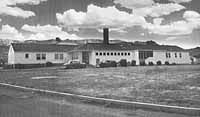| The Carbon Medical Services Assocatiion was originally housed in the same building with the Utah Permanente Hospital in Dragerton (now East Carbon). This building was later torn down and the clinic itself was erected on the same spot. Today the clinic serves over 2000 people a year. |
The Carbon Medical Clinic celebrated birthday number 50 on Tuesday afternoon and the party included people who were there when it began and others who have utilized the facility for only a short time.
Nearly 50 people packed into the little conference/waiting room area at one time along with dozens of flowers and lots of good food during the ceremony. Over the entire afternoon over 150 people visited the facility.
“This clinic has always helped people whether they had any money or not,” said Evonne Jensen, Executive Director of the clinic and someone who worked with the clinic since some of it’s earliest days. “This has been a real community project in the last half century. Everyone has added to it.”
The clinic was formed to meet the needs of coal miners in Carbon and Emery counties in 1952. It was run by an association of people, all of which came from the community and the United Mine Workers of America.
The original clinic was housed in the Utah Permanente Hospital that stood on the same site as the current clinic which was built in the 1970’s.
In 1974 the hospital was torn down and all it’s services were transferred to the Carbon County Hospital. The clinic continued to operate and provide physician and pharmacy services.
The clinic has certainly seen it’s ups and downs, particularly in the areas of funding. The mines in the area were largely the funding source for the facility and how their fortunes went, so did the clinics for many years. None the less the clinic provided services for those that were fortunate and those not so.
In 1985, when Kaiser Steel declared bankruptcy at the mine and then later the United States Steel Mine also closed, it became evident that there was trouble ahead. The clinic which had relied on mine support was now left to collect money from patients, many of who had insurance that had paid monies directly to them. Unfortunately, they were unable to recoup much of that money and it made the situation more dire.
Not long after Sunnyside Coal took over the Kaiser mine, but after only a short time operating, they too declared bankruptcy. It was a blow that could have put the clinic out of business, but the operations board of directors decided to look for a new way to fund the clinic so it could stay in the East Carbon area. First officials checked to see if the hospital in Price would operate it but the answer was no.
Finally they decided that staying a non-profit organization would help and the board connected itself with the Utah Community Health and the State Bureau of Primary Care/Rural Health Association. At that time it was decided if the clinic could not get federal help it would have to close.
In April of 1992 the clinic received a “federally qualified health center” designation which made it eligible for federal grant money. In October of 1992 the clinic received $89,106 from their first grant.
The board reorganized once again and the facility became a Community Health Center. Since that first grant the clinic has been able to attract almost one and a half million dollars in federal money and $240,000 in state primary care grant money.
| Carbon Clinic executive director Evonne Jensen hugs Andrew Jack Smith during the ceremonies on Tuesday afternoon. Jensen began working in the clinic in the late 1950’s and Smith was one of the original founding members of the association in 1952. |
Currently the clinic serves about 2000 people who incur about 6300 visits per year.
The clinic is one of the largest employers in the East Carbon area with 14 full time employees.
Along with the federal money has come a lot of private company support from pharmaceutical companies and other medical supply providers. This has led to a lot of people getting prescriptions filled who would not be able to afford it otherwise.
“This facility has a very busy pharmacy,” said Jensen. “Busier than a lot of much larger facilities.”
Joyce Caveness who works in the pharmacy estimates that they fill 125 prescriptions per day, a lot of them going out to people who would otherwise have to go without.
“It’s really nice to work somewhere where people come that can’t afford it and we can help them,” she said during the celebration.
The Carbon Clinic also has a branch pharmacy in the Green River Clinic which has provided over $55,000 in medication assistance to patients there.
Russell Hunt, physicians assistant at the clinic probably summed it up for everyone who works at the facility.
“I feel I can help people without having to rob them,” he said.
Dr. Kurt King the supervising physician at the clinic also was there and he told the audience his ties were stronger than just working there.
“I was born at the old Dragerton Hospital, so I have some deep roots here,” he said.
Officials from many agencies attended the party along with other community health center personnel from places as diverse as Enterprise (near St. George) and Ogden.
The center also made a special presentation to Ronald Madsen from Senator Orrin Hatch’s office honoring the senator for his commitment to community health care in Utah over the years.

